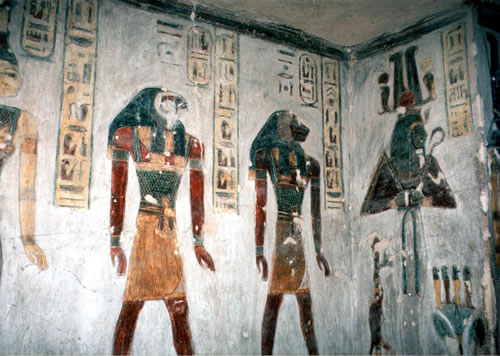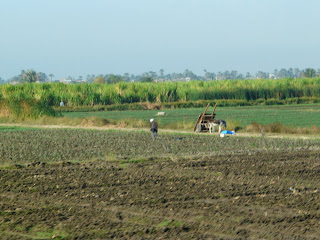Luxor-farmland close to the Nile River.
Small farms near Luxor.
Where there is water, the land is green.
Donkey carts-a primary mode of transport for the local farmers.
More donkeys.
Between the temples of Karnak and Luxor, they found a row of Sphinx lining the ancient street. The distance between the two temples is 3 kilometers. There are estimated to be 1200 Sphinx--many yet to be uncovered.
The mortuary temple of Hatshepsut-the female Pharaoh. She ruled Egypt for over 20 years as the Pharaoh. For a woman to rule for this long was very unusual. Other royal women had ruled as king, but only when there were no male heirs to the throne. Their reigns were short and generally came at the end of a dynasty.
Hatshepsut's father was Tuthmosis I, her mother, Ahmose, was the royal queen (the primary wife of the pharaoh). She was married to her half-brother, Tuthmosis II. At the death of Tuthmosis II, the crown prince, Tuthmosis III was still a child (about 7 years old). Hatshepsut was the mother of only one child--a daughter. The daughter was then married to her half-brother, Tutmosis III.
Hatshepsut took over control of the government and sent the young crown prince away to the military. She left him there for the duration of her reign--about 20 years. Hatshepsut built this temple in her honor. After her death, her son-in-law, Tuthmosis III came into power. He took revenge upon Hatshepsut by destroying everything in Hatshepsut's temple with her name or picture. Tuthmosis III couldn't destroy the temple because it was considered sacred--but that didn't stop him from eliminating her name from the temple.
Hatshepsut's Temple.
Tombs on the side of the hill next to Hatshepsut's temple. These tombs are for high government officials--most of them who were not royalty. The Valley of the Kings is on the back side of this hill.
Angus at the Temple.
Native dress of Egyptian women.
Statues at the temple
Look closely at this drawing. It shows the child, Hatshepsut nursing from the cow. The cow represented the royal line. This drawing indicates that Hatshepsut was from royal blood and that she was the rightful heir to rule the country.
Pillars and statues from the chapel at the temple.
Levels II and III at the temple.
This is a carving of the female King Hatshepsut--the face has been cut out.
Looking from the Temple of Hatshepsut towards Luxor. Notice the dramatic difference as you get close to the Nile. The Nile is the lifeblood of Egypt. Without the Nile, Egypt would not have become the ancient powerful kingdom.
Statues of an ancient temple that was destroyed by an earthquake.
These represent Amenhotep III.
The Valley of the Kings--During the New Kingdom, the Pharaohs were buried here. The pyramids were no longer used because they were known to hold the treasures of the pharaohs and ancient tomb robbers were stealing from them even in ancient times. It also required enormous amounts of resources (labor and rock) to build the pyramids. This site was chosen because it is isolated and because it has a natural pyramid (notice the shape of the mountain).
Cameras were not allowed to be taken into the Valley of the Kings. We were able to enter the tombs of Ramses I, Ramses III, and Ramses IX. We also saw the tomb of King Tut (Tutankhamun) which was the best preserved of all of the tombs. It wasn't discovered until 1917 and finally opened in 1922--with the treasures and the mummy still in place. Most of the tombs were robbed earlier and the artifacts scattered throughout the world.
(The next 4 photos were copied off of the internet)

The Valley of the Kings--sleeping place of the Pharaohs. 62 known tombs are located in this valley.

Paintings on the wall of a pharaoh's tomb.

Egyptian hieroglyphics in a tomb.

Sarcophagus of Ay--Pharaoh
These represent Amenhotep III.
The Valley of the Kings--During the New Kingdom, the Pharaohs were buried here. The pyramids were no longer used because they were known to hold the treasures of the pharaohs and ancient tomb robbers were stealing from them even in ancient times. It also required enormous amounts of resources (labor and rock) to build the pyramids. This site was chosen because it is isolated and because it has a natural pyramid (notice the shape of the mountain).
(The next 4 photos were copied off of the internet)

The Valley of the Kings--sleeping place of the Pharaohs. 62 known tombs are located in this valley.

Paintings on the wall of a pharaoh's tomb.

Egyptian hieroglyphics in a tomb.

Sarcophagus of Ay--Pharaoh



















5 comments:
What fun this is one of the places that I wan to see someday.
WOW, pretty dirt.
Okay so those are pretty cool pics. After watching Spitfire though, it makes me wonder at their sanity if they worship cats!! She is absolutely nuts right now. You would think we had an indoor racing arena with how she tears around at night.
Hey Lamar your brother Lane wanted me to say hi, I was the random guy that works with your brother that you met in Egypt.
-Steve Kuhmichel
Cool photos. It reflects fun you had.
The Egypt Hatshepsut Temple is one of the most characteristic temples in the whole of Egypt, due to its design and decorations.
Post a Comment